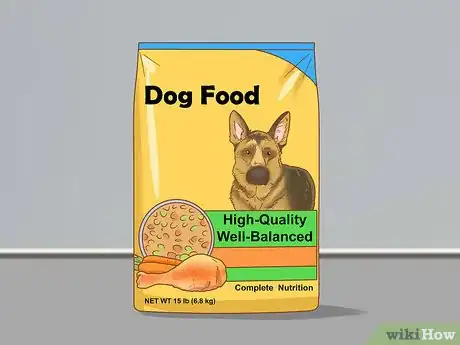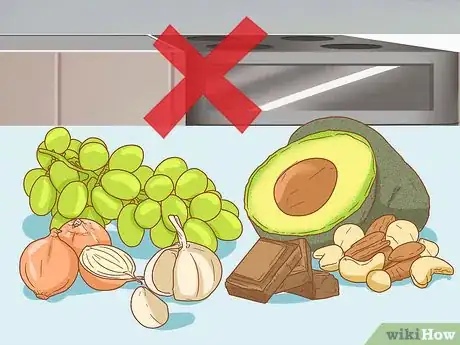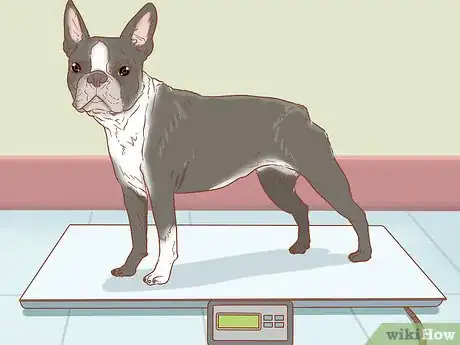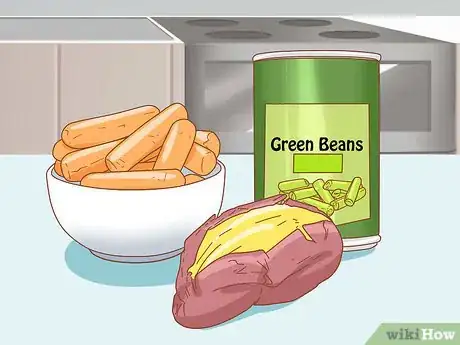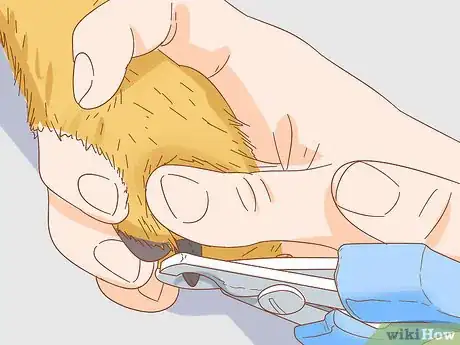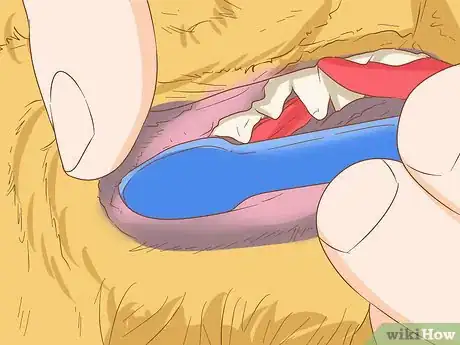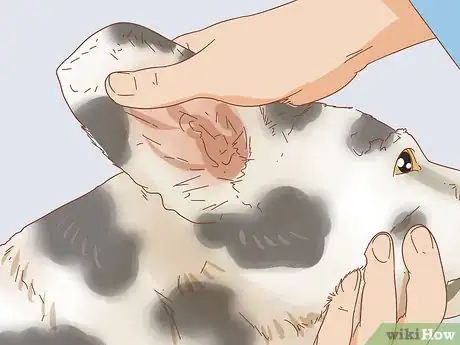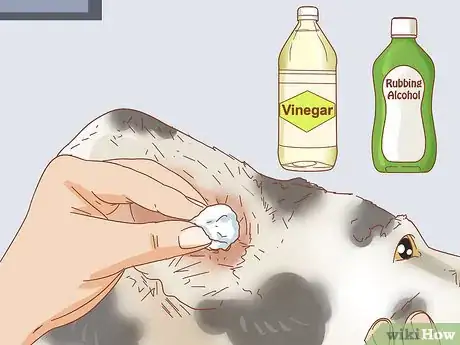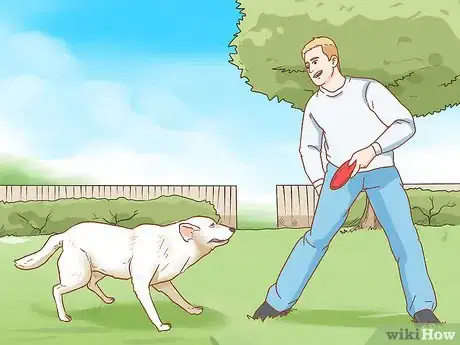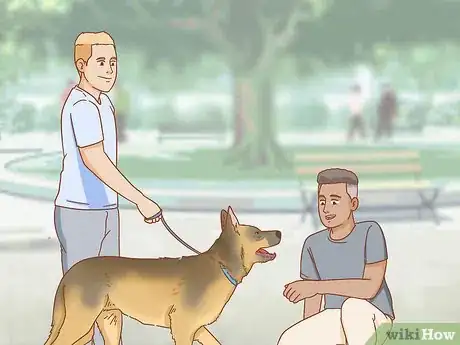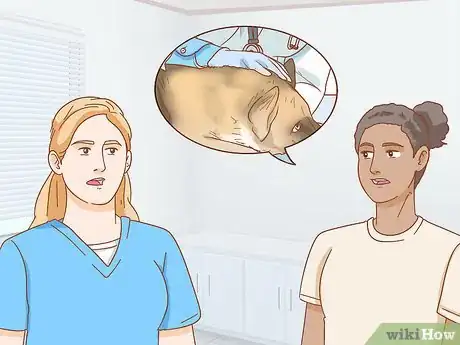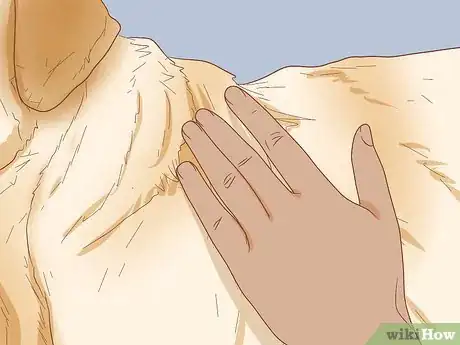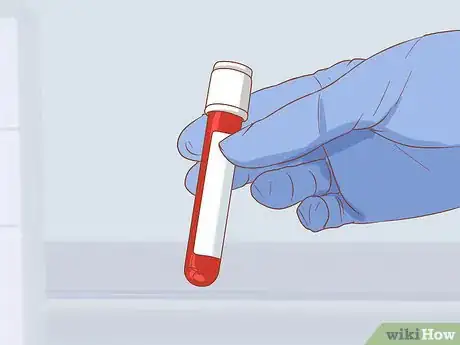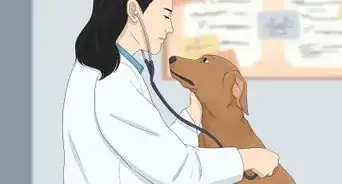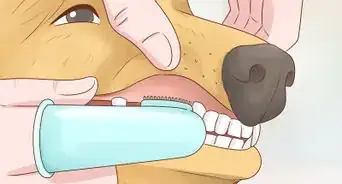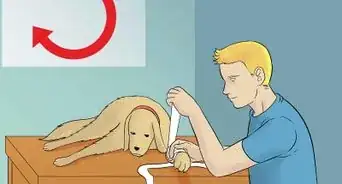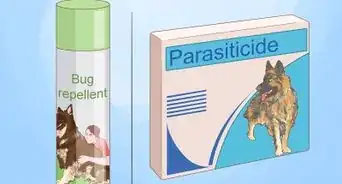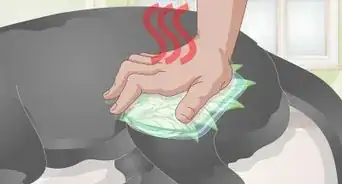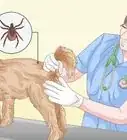This article was co-authored by Rendy Schuchat. Rendy Schuchat is a Certified Professional Dog Trainer and the Owner of the largest dog training facility, Anything Is Pawzible, based in Chicago, Illinois. With over 20 years of experience, Rendy specializes in positive dog training and behavior modification to help people build and strengthen their relationships with their dogs. She holds a BA in Psychology and Communications from the University of Iowa, an MA in Psychology from Roosevelt University, and a Certification in Dog Obedience Instruction from Animal Behavior Training and Associates. Rendy was voted one of the Best/Favorite Dog Trainers in Chicago by Chicagoland Tails Reader’s Choice Awards multiple times and was voted Chicago Magazine’s “Best Dog Whisperer” in 2015.
There are 7 references cited in this article, which can be found at the bottom of the page.
wikiHow marks an article as reader-approved once it receives enough positive feedback. In this case, 100% of readers who voted found the article helpful, earning it our reader-approved status.
This article has been viewed 143,302 times.
It's only natural that you want to take care of your dog so he'll be by your side for years. The good news is that there are lots of things you can do to care for your dog. Learn how to maintain a good diet of high quality food, get preventative veterinary care, and do your best to provide a healthy, loving environment.
Steps
Maintaining a Good Diet
-
1Feed your dog high-quality, well-balanced dog food and treats. Making sure your dog eats a nutritious diet is an important part of protecting their health.[1] Look at the first five ingredients listed on the pet food label. These ingredients make up the majority of the food. Meat (not meat by-products) and vegetables should be the first few ingredients in the dog food. Lower down the list may be meat by-products and grains.[2]
- Avoid common filler ingredients in dog food that may actually harm your dog's health. Some of these include: Ethoxyquin, Propylene Glycol, BHT/BHA, Corn Syrup and corn, and animal by-products.[3]
- Occasionally, some dogs might show signs of a food sensitivity or intolerance. Watch for: diarrhea, vomiting, or skin conditions. Work with the veterinarian to determine what food ingredients the dog can and cannot eat.
-
2Be careful when feeding your dog human food. Realize that certain human foods can hurt or kill a dog. Dog’s bodies can’t always metabolize foods like humans can so make sure your dog does not have access to these foods: grapes, raisins, chocolates, avocados, yeast dough, nuts, alcohol, onions, garlic, chives, and sugar-free gum (mainly the ingredient xylitol[4] [5] ). These are all toxic to dogs.
- While you can make your own dog food, you must work with an animal nutritionist or veterinarian with education in pet food nutrition. This ensures your dog’s diet is nutritionally balanced.
Advertisement -
3Maintain your dog's weight at a healthy level. A dog is considered overweight when he weighs 10-20% more than his ideal body weight. If he is 20% overweight, he's considered obese. Being obese can shorten a dog’s life span by 2 years. Obese dogs are at higher risk for cancer, heart disease, diabetes, osteoarthritis, and urinary bladder stones.[6] Talk with a vet about the ideal weight for your dog and feed him accordingly.
- Most dogs are overweight or obese because they don't get enough exercise and get too much food. Refer to the package of pet food for specific guidelines about feeding based on ideal weight.
-
4Give your dog healthy treats. Just like in humans, snacking or treats, can add quite a few calories to a dog’s daily calorie allowance. This could cause your dog to put on extra weight. Try giving your dog homemade treats, instead of store bought ones.[7]
- Give your dog low calorie treats like baby carrots, canned green beans (low sodium or rinsed to wash off the added salt), or small slices of cooked sweet potatoes.
-
5Give your dog a constant supply of fresh water. Dogs need lots of fresh water for the body to properly work and digest food. The water should be clean and fresh, so change the water at least once a day. Clean the water bowl or bucket with dish soap and water every once. Rinse and dry the container before refilling with fresh water.
- Bacteria and algae can grow in the bowl, especially during warm weather. In freezing temperatures, you'll need to keep the bowl from freezing.
Grooming Your Dog
-
1Groom your dog regularly. Brush your dog's coat to keep it shiny and healthy. This will also encourage good circulation. Note any new lumps, bumps, or cysts on the skin and bring them to your veterinarian’s attention. Scabs, redness, or itchy skin should also be addressed by a veterinarian.
- Grooming is also a good time to check for skin conditions like fleas, ticks, and mites.
-
2Clip your dog's nails only if you know how. While it may take a little time for you dog to get used to, clipping the nails can become a routine part of grooming. Just be careful not to trim the "quick," the part of the nail that contains sensitive blood vessels and nerves. This is impossible to see if the dogs nails are black and he will need the vet nurse to do it.
- If you aren’t sure how to clip the nails, have your veterinarian technician show you how to clip your dog's nails.
-
3Brush your dog's teeth every day.[8] Brushing lets you remove any plaque or bacterial build up on your dog’s teeth. This is also a good chance to check the mouth for sores, loose or damaged teeth, or any other odd problems. Only use a dental toothpaste made for dogs. The fluoride in human toothpaste is poisonous to dogs and can cause serious health problems.[9]
- Occasionally, your dog will need a dental cleaning at the vet's office. He'll be sedated while the veterinarian performs a thorough examination and cleaning.
-
4Check your dog's ears. The ears shouldn't smell or have any discharge. The inner part of the ear should be a whitish color; but some dark colored dogs may have dark colored inner ears. Flip the ear over to inspect it. It should be clear of dirt, debris, or parasites like ticks. Plant material can sometimes work their way into the ear. These should be carefully removed.[10]
- If your dog has floppy type ears, they should be checked daily, otherwise check them regularly.
-
5Clean your dog's ears. Use a product specifically made to clean dog’s ears or use a solution of half white vinegar and half rubbing alcohol. Saturate a cotton ball with the fluid and gently wipe out the dog’s ear. If blood appears on the cotton ball stop cleaning and consult your veterinarian.[11]
- Shaking the head excessively, scratching or pawing at the ear, odor, or discharge (waxy, fluid, or brown) is not normal. If you think your dog has an ear infection or other ear problem, take him to the vet.
Caring For Your Dog
-
1Offer your dog shelter. Most people with pet dogs chose to keep them in the house with the family. If you do keep your dog outside, provide an insulated dog house, warm bedding for cold climates, shade for warm climates, food, and water (that won't freeze or stagnate). Never chain your dog, since this could cause leg or neck injuries.
- Don't keep your dog outside if he hasn't acclimated to weather extremes. It is considered negligence to keep a dog outside without proper shelter. If you can't shelter your dog correctly, keep him inside or don't get a dog in the first place.
-
2Get your dog plenty of exercise. Depending on your dog’s breed, this could be anything from a 10-15 minute walk per day to a good hour romp in the park. A fun game of fetch or Frisbee can also be physically challenging to very active dogs. Playing or walking is a great chance for you to bond with your dog.
- Exercise and playing can cut back on bad behavior, like tearing things up around the house, inappropriate chewing, and aggression. It will also keep your dog’s weight down and his body healthy.
- In addition to exercise, make sure you're giving your dog plenty of enrichment to stimulate their brain. For instance, teach them to solve puzzles and do tricks, and practice agility and advanced obedience.[12]
-
3Socialize your dog. Once he's gotten all his important first vaccinations, socialize him. This means carefully introducing him to people, other animals and dogs, and situations outside the immediate home environment. Getting used to riding in the car, walking around the neighborhood and dog parks are great ways to introduce him to people and other dogs.
- As long as the dog isn’t scared or threatened he will get used to these situations. The more unique social situations you expose your dog to when he's young, the better.
Providing Routine Health Care
-
1Take your dog to the veterinarian. Schedule yearly examinations so you dog can get important tests and vaccinations done. Your vet will also get to know your dog and will be able to tell if something's wrong with his health. Regular check-ups can prevent many treatable diseases.[13]
- If you have a puppy, take it to the vet around 6 weeks old. The puppy will be checked for hernias, heart, lung, eye, and ear problems. The puppy will also be put on a preventative de-worming schedule and given important early shots and boosters.
-
2Get your dog vaccinated. The rabies vaccination should be given around 12 weeks and is required in many areas. You might be severely penalized if you haven't vaccinated your dog and he nips or bites a person or another pet. Consider vaccinating your dog against Lyme disease. This disease causes joint pain, swelling, fever, and possibly fatal kidney disease.[14]
- Dogs that spend a lot of time outside, live on farms, or hunt are at increased risk of getting this tick-borne disease.
-
3Consider spaying or neutering your dog. Spaying or neutering your dog can reduce some behavioral problems and decrease the chance of certain tumors and infections. If you spay or neuter your dog, you won't need to worry about caring for or placing unwanted puppies.[15]
- Microchipping is also encouraged in case your dog ever becomes lost.
-
4Monitor and prevent fleas. Watch for signs of fleas on your dog: dark specks in the fur, lots of licking and scratching, or scabs on the skin.[16] Once you've found fleas on your dog, you have several options. See your vet for an oral medication, wash your dog with flea shampoo, and put a flea collar on your dog.
- Flea collars and monthly skin treatments are good ways to prevent fleas in the first place. Talk with your vet about a regular flea prevention routine.[17]
-
5Have your dog tested for heartworm. A yearly blood test is needed to check for this widespread disease. Heartworm is spread by mosquito bites so it's hard to prevent. Instead, a monthly tablet or a shot which lasts for up to 6 months is used to kill any organisms present in the blood stream.[18]
- If your dog does get heartworm disease, there is a treatment but it is hard on him, expensive, and can take months to combat.
Expert Q&A
Did you know you can get expert answers for this article?
Unlock expert answers by supporting wikiHow
-
QuestionHow do I keep my dog healthy and avoid going to the vet?
 Pippa Elliott, MRCVSDr. Elliott, BVMS, MRCVS is a veterinarian with over 30 years of experience in veterinary surgery and companion animal practice. She graduated from the University of Glasgow in 1987 with a degree in veterinary medicine and surgery. She has worked at the same animal clinic in her hometown for over 20 years.
Pippa Elliott, MRCVSDr. Elliott, BVMS, MRCVS is a veterinarian with over 30 years of experience in veterinary surgery and companion animal practice. She graduated from the University of Glasgow in 1987 with a degree in veterinary medicine and surgery. She has worked at the same animal clinic in her hometown for over 20 years.
Veterinarian Good health is a product of eating a healthy balanced diet, being the correct weight, using regular anti-parasite treatments to prevent illness, and giving plenty of mental and physical stimulation. Start with a good diet and avoid overfeeding, as obesity leads to health problems such as diabetes, joint disease, cancer, and heart problems. Give your dog the correct amount of exercise so your dog is kept active, and play regularly with your dog to provide mental stimulation and prevent boredom.
Good health is a product of eating a healthy balanced diet, being the correct weight, using regular anti-parasite treatments to prevent illness, and giving plenty of mental and physical stimulation. Start with a good diet and avoid overfeeding, as obesity leads to health problems such as diabetes, joint disease, cancer, and heart problems. Give your dog the correct amount of exercise so your dog is kept active, and play regularly with your dog to provide mental stimulation and prevent boredom. -
QuestionHow often should my dog see the vet?
 Pippa Elliott, MRCVSDr. Elliott, BVMS, MRCVS is a veterinarian with over 30 years of experience in veterinary surgery and companion animal practice. She graduated from the University of Glasgow in 1987 with a degree in veterinary medicine and surgery. She has worked at the same animal clinic in her hometown for over 20 years.
Pippa Elliott, MRCVSDr. Elliott, BVMS, MRCVS is a veterinarian with over 30 years of experience in veterinary surgery and companion animal practice. She graduated from the University of Glasgow in 1987 with a degree in veterinary medicine and surgery. She has worked at the same animal clinic in her hometown for over 20 years.
Veterinarian A healthy adult dog should have a vet checkup at least once a year, when they have their annual vaccination. However, twice a year, or every six months, is preferable. As the dog ages, especially once they are over the age of 7 (when they are now considered a senior citizen), then a minimum of two checks a year is necessary.
A healthy adult dog should have a vet checkup at least once a year, when they have their annual vaccination. However, twice a year, or every six months, is preferable. As the dog ages, especially once they are over the age of 7 (when they are now considered a senior citizen), then a minimum of two checks a year is necessary. -
QuestionHow can I make sure my dog stays healthy?
 Rendy SchuchatRendy Schuchat is a Certified Professional Dog Trainer and the Owner of the largest dog training facility, Anything Is Pawzible, based in Chicago, Illinois. With over 20 years of experience, Rendy specializes in positive dog training and behavior modification to help people build and strengthen their relationships with their dogs. She holds a BA in Psychology and Communications from the University of Iowa, an MA in Psychology from Roosevelt University, and a Certification in Dog Obedience Instruction from Animal Behavior Training and Associates. Rendy was voted one of the Best/Favorite Dog Trainers in Chicago by Chicagoland Tails Reader’s Choice Awards multiple times and was voted Chicago Magazine’s “Best Dog Whisperer” in 2015.
Rendy SchuchatRendy Schuchat is a Certified Professional Dog Trainer and the Owner of the largest dog training facility, Anything Is Pawzible, based in Chicago, Illinois. With over 20 years of experience, Rendy specializes in positive dog training and behavior modification to help people build and strengthen their relationships with their dogs. She holds a BA in Psychology and Communications from the University of Iowa, an MA in Psychology from Roosevelt University, and a Certification in Dog Obedience Instruction from Animal Behavior Training and Associates. Rendy was voted one of the Best/Favorite Dog Trainers in Chicago by Chicagoland Tails Reader’s Choice Awards multiple times and was voted Chicago Magazine’s “Best Dog Whisperer” in 2015.
Certified Professional Dog Trainer
Warnings
- Don't give your dog small balls to play with. They can get stuck in the dog's windpipe and suffocate the dog.⧼thumbs_response⧽
- Very hard bones, rocks, and sticks can crack or damage teeth in dogs that are aggressive chewers.⧼thumbs_response⧽
- Never give your dog cooked bones or fatty foods. Bones can get lodged in the intestinal tract and your dog will need expensive surgery to fix this. Fatty foods can give your dog a painful case of pancreatitis and lead to expensive veterinary interventions.⧼thumbs_response⧽
References
- ↑ Rendy Schuchat. Certified Professional Dog Trainer. Expert Interview. 26 January 2021.
- ↑ The Merck Veterinary Manual. C.M. Kahn and S. Line (eds.) 2010. John Wiley & Sons.
- ↑ http://iheartdogs.com/5-ingredients-you-never-want-to-find-in-your-dogs-food/
- ↑ The Merck Veterinary Manual. C.M. Kahn and S. Line (eds.) 2010. John Wiley & Sons.
- ↑ The 5 Minute Veterinary Consult. L.P Tilley and F.W. K. Smith, Jr. (eds) 2000. Blackwell
- ↑ Small Animal Internal Medicine. 5th Edition. R.W. Nelson and C.G. Couto. Elsevier Health Sciences. 2014
- ↑ Small Animal Internal Medicine. 5th Edition. R.W. Nelson and C.G. Couto. Elsevier Health Sciences. 2014
- ↑ https://www.aspca.org/pet-care/virtual-pet-behaviorist/dog-behavior/brushing-your-dogs-teeth
- ↑ Small Animal Internal Medicine. 5th Edition. R.W. Nelson and C.G. Couto. Elsevier Health Sciences. 2014
- ↑ The 5 Minute Veterinary Consult. L.P Tilley and F.W. K. Smith, Jr. (eds) 2000. Blackwell
- ↑ The 5 Minute Veterinary Consult. L.P Tilley and F.W. K. Smith, Jr. (eds) 2000. Blackwell
- ↑ Rendy Schuchat. Certified Professional Dog Trainer. Expert Interview. 26 January 2021.
- ↑ The Merck Veterinary Manual. C.M. Kahn and S. Line (eds.) 2010. John Wiley & Sons.
- ↑ The Merck Veterinary Manual. C.M. Kahn and S. Line (eds.) 2010. John Wiley & Sons.
- ↑ The Merck Veterinary Manual. C.M. Kahn and S. Line (eds.) 2010. John Wiley & Sons.
- ↑ http://pets.webmd.com/ss/slideshow-flea-and-tick-overview
- ↑ http://pets.webmd.com/ss/slideshow-flea-and-tick-overview
- ↑ The Merck Veterinary Manual. C.M. Kahn and S. Line (eds.) 2010. John Wiley & Sons.
About This Article
To keep a dog in good health, feed it high-quality food and treats that contain meat and vegetables as the first few ingredients. Also, avoid overfeeding your dog, since being 20 percent over its ideal body weight can shorten a dog’s lifespan by 2 years. Additionally, walk your dog at least once a day to keep its weight down and prevent it from getting bored and frustrated. You should also take your dog to the vet once a year, which can help prevent many treatable diseases. For more advice from our Veterinary co-author, including how to groom and socialize your dog, keep reading!
